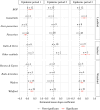Utilizing citizen science data to rapidly assess changing associations between wild birds and avian influenza outbreaks in poultry
- PMID: 39317317
- PMCID: PMC11421901
- DOI: 10.1098/rspb.2024.1713
Utilizing citizen science data to rapidly assess changing associations between wild birds and avian influenza outbreaks in poultry
Abstract
High pathogenicity avian influenza virus (HPAIV) is a rapidly evolving virus causing significant economic and environmental harm. Wild birds are a key viral reservoir and an important source of viral incursions into animal populations, including poultry. However, we lack a thorough understanding of which species drive incursions and whether this changes over time. We explored associations between the abundances of 152 avian species and outbreaks of highly pathogenic avian influenza (HPAI) in poultry premises across Great Britain between October 2021 and January 2023. Spatial generalized additive models were used, with species abundance distributions sourced from eBird. Associations were investigated at the species-specific level and across species aggregations. During autumn/winter, associations were generally strongest with waterbirds such as ducks and geese; however, we also found significant associations in groups such as non-native gamebirds and rapid change in species-specific associations over time. Our results demonstrate the value of citizen science to rapidly explore wild species as potential facilitators of disease incursions into well-monitored populations, especially in regions where viral surveillance in wild species is limited. This can be a critical step towards prioritizing targeted surveillance that could inform species-specific biosecurity measures; particularly for HPAIV, which has undergone sudden shifts in host range and continues to rapidly evolve.
Keywords: HPAIV; disease vector; eBird; spillover; viral incursion.
Conflict of interest statement
We declare we have no competing interests.
Figures





Similar articles
-
Mapping the risk of introduction of highly pathogenic avian influenza to Swedish poultry.Prev Vet Med. 2024 Sep;230:106260. doi: 10.1016/j.prevetmed.2024.106260. Epub 2024 Jun 29. Prev Vet Med. 2024. PMID: 38976955
-
Investigating the Genetic Diversity of H5 Avian Influenza Viruses in the United Kingdom from 2020-2022.Microbiol Spectr. 2023 Aug 17;11(4):e0477622. doi: 10.1128/spectrum.04776-22. Epub 2023 Jun 26. Microbiol Spectr. 2023. PMID: 37358418 Free PMC article.
-
A multi-species, multi-pathogen avian viral disease outbreak event: Investigating potential for virus transmission at the wild bird - poultry interface.Emerg Microbes Infect. 2024 Dec;13(1):2348521. doi: 10.1080/22221751.2024.2348521. Epub 2024 Jun 10. Emerg Microbes Infect. 2024. PMID: 38686548 Free PMC article.
-
The genetics of highly pathogenic avian influenza viruses of subtype H5 in Germany, 2006-2020.Transbound Emerg Dis. 2021 May;68(3):1136-1150. doi: 10.1111/tbed.13843. Epub 2020 Sep 29. Transbound Emerg Dis. 2021. PMID: 32964686 Review.
-
Origin and evolution of highly pathogenic H5N1 avian influenza in Asia.Vet Rec. 2005 Aug 6;157(6):159-64. doi: 10.1136/vr.157.6.159. Vet Rec. 2005. PMID: 16085721 Review.
Cited by
-
The spread of highly pathogenic avian influenza virus is a social network problem.PLoS Pathog. 2025 Jul 7;21(7):e1013233. doi: 10.1371/journal.ppat.1013233. eCollection 2025 Jul. PLoS Pathog. 2025. PMID: 40622959 Free PMC article.
References
MeSH terms
Grants and funding
LinkOut - more resources
Full Text Sources
Medical

